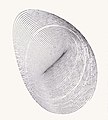Harmonograph
From Wikipedia, the free encyclopedia
A harmonograph is a mechanical apparatus that employs pendulums to create a geometric image. The drawings created typically are Lissajous curves, or related drawings of greater complexity. The devices, which began to appear in the mid-19th century and peaked in popularity in the 1890s, cannot be conclusively attributed to a single person, although Hugh Blackburn, a professor of mathematics at the University of Glasgow, is commonly believed to be the official inventor.[1]
A simple, so-called 'lateral' harmonograph uses two pendulums to control the movement of a pen relative to a drawing surface. One pendulum moves the pen back and forth along one axis and the other pendulum moves the drawing surface back and forth along a perpendicular axis. By varying the frequency of the pendulums relative to one another (and phase) different patterns are created. Even a simple harmonograph as described can create ellipses, spirals, figure eights and other Lissajous figures.
More complex harmonographs incorporate three or more pendulums or linked pendulums together (for example hanging one pendulum off another), or involve rotary motion in which one or more pendulums is mounted on gimbals to allow movement in any direction.
A particular type of harmonograph, a pintograph, is based on the relative motion of two rotating disks, as illustrated in the links below.
[edit] Gallery
[edit] Notes
- ^ Turner, S: "Demonstrating Harmony: Some of the Many Devices Used To Produce Lissajous Curves Before the Oscilloscope", Rittenhouse, Vol. 11, Issue 42, page 41, February 1997.
[edit] External links
- Flash Harmonograph applet
- A complex harmonograph with a unique single pendulum design
- Free plans: how to make a Large Harmonograph
- more about harmonographs
- Online interactive Harmonograph
- Beautiful interactive Harmonograph with fast live changes
- Harmonograph background, equations, and illustrations
- A lateral harmonograph in action and a simple Excel spreadsheet
- Simulating Harmonographs using Mathematica
- A pintograph in action and an Excel spreadsheet model






